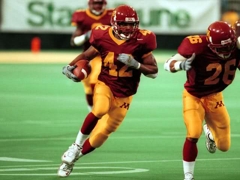I can smell basketball in the air. That glorious time of the year has snuck up on us and we will be inundated with hoops madness. As a prelude to another season, I thought I would share with you an inside look into one of the games most misunderstood people: the OFFICIAL. Let’s see what these special and dedicated people do each night to ensure that the game is fair for each team.
The basketball official takes the floor before each game to observe the teams as they warm up. The coaches, players, and spectators form opinions on the pinstripes: he looks old, she looks slow, let’s hope he is better than the last time we had him, he cost us a game last year. Every call will get analyzed, criticized, and magnified. The horn sounds and the game is ready to start.
The opening tap sets the tone for the game. If the toss is good/straight/at the right height that is only the first step. Did the two jumpers touch the ball once, twice, or not at all? Did the non-jumpers move too soon? When the ball was tapped controlled did the teams go in the correct direction (away from your bench in the first half and towards your bench in the second half). The alternating possession arrow needs to be set to the team who did not win the tap. This will come into play to decide the next held ball or to start the next quarter. Wow! That was just the opening tap.
The official has primary areas where he is looking to see if illegal contact has occurred. Once he sees this: TOOT! RED 32 HITS TWO SHOTS. The official makes sure that the lane is inhabited correctly (four from the non shooting team and two from the shooting team in most cases). He announces two shots, signals with two fingers and bounces the ball to the foul shooter. Both officials also police that the players in the lane do not leave their spots until the ball hits the rim (high school rules). The shooter has ten seconds to attempt the free throw. Shot is up and good. TIME OUT BLUE! Coach of blue calls a thirty second timeout. Red will inbound and can run the baseline.
On the ensuing inbound, the official hands the ball to the thrower and raises one hand and counts to five seconds with the other hand. Once the ball has been put into play under five seconds he chops with the raised hand which alerts the time keeper to start the clock. The team with the ball has ten seconds to advance over half court (both feet and the ball). If the official hits ten seconds we have a ten second violation.
Some of the fouls called in a game are a push, hand check, hold, offensive/player control foul, illegal screen, and illegal contact. Some of the violations are traveling (walking), carrying, three seconds in the lane, back court, and double dribble to name a few.
The average fan does not understand that the action is non-stop and your eyes have to watch every part of the play. If you see five frames of action you can better determine what happened. Most people see two frames and it does not tell the whole story. Coaches tend to see the frames that help their team.
Here are a few things that the fans need to realize about basketball officials. They do not care who wins the game!!! They are there to enforce all of the rules of the game NOT the ones you want them to enforce. They are impartial and call what they see. They know the rules better than the coaches, the players, and the fans. They only get one shot to get the call right and that shot happens in a very small window of time. There will be contact during the game that is not necessarily illegal contact. Just because someone looks like they walked with the basketball does not mean it was a travel. The key to traveling is the pivot foot and possession of the ball. They watch for it. THERE IS NO SUCH THING AS A MAKEUP CALL!!!
Officiating has two components to it: art and science. The science part says if player A has legal guarding position and player B tries to run him over, that constitutes a player control foul. The art part relates to looking at a play in its totality and determining who initiated contact. Did an advantage or a disadvantage occur? Holding your whistle while the play starts, develops and finishes is the hardest thing to do in officiating and the best officials have this
The following is a compilation of things that officials hear during a game: call it both ways, you are not being fair, three seconds, how did you miss that push down there, my player is getting fouled on every drive to the basket. Officials are taught to answer questions but leave comments alone unless someone goes over the line. Then we enter the Technical Foul zone.
Watch the officials the next time you are at a game. You will be shocked at the number of hours they spend attending meetings, discussing plays, reading the rule book in order to master their craft. No one has ever had a perfect game but they strive for it every game. And when the game is over they scrutinize the plays they just called. And they are tougher on themselves than the fans were. All in the quest to be the best they can be.
Let’s enjoy the greatest time of the year watching the best game in the world. And take it easy on the officials. They work hard and get it right most of the time. They really do!!!
Add The Sports Daily to your Google News Feed!
